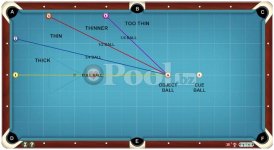Nice shooting Dave.
I'm a 100% feel player, with no idea of contact points, fractions, lines, ghostballs, etc. I'd like to repeat your test sometime soon. I'd like to do it first shooting normally, to get a baseline, and then with a cover over the table like you had. I expect to shoot lower than you, because I'm a lower level player than you. However, I don't think the cover will make much of a difference on my personal shooting, if I make it exactly like you had it. The reason is, I believe your eyes picked up what is left of the long rail before the cover starts, and also the intersection of the side and end rail where the pocket would be.
I'm not knocking the CTE method at all. I just think the way you had the table covered allowed your brain to "see" where the pocket was.
Edit: Added all below:
You need a few 4x8 sheets of plywood, that someone else will put over the table (so you can't see the setup). The sheet should not be centered on the table, so you can't use the sheet's edges as a "guide" for your eye.
You need to cover the rails near the cueball as well, so you don't see anything. Then, have a helper set up a 2 shots. What YOU define as thick, and what YOU define as thin, like PJ asked you above. He will tell you if the shot is thick or thin. All you can see is the cueball and object ball, and the rest of the table is covered. Then, you shoot the two shots 10 times each, and record the results.
I hypothesisze you won't make any shots if:
1. You can only see the cueball and object ball
2. You can't see any of the table features
3. The shots are set up thick and thin based on YOUR definition.
